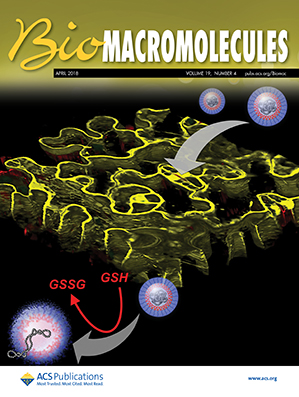Antimicrobial Vitrimers Synthesized from Dipentaerythritol Pentaacrylate and 2‑Hydroxy-3-phenoxypropyl Acrylate for LCD 3D Printing
IF 5.4
2区 化学
Q1 BIOCHEMISTRY & MOLECULAR BIOLOGY
引用次数: 0
Abstract
In this study, two monomers, dipentaerythritol pentaacrylate and 2-hydroxy-3-phenoxypropyl acrylate, were used to synthesize antimicrobial vitrimers with and without a transesterification catalyst and investigate their properties. The addition of the comonomer 2-hydroxy-3-phenoxypropyl acrylate to the photocurable resin reduced its viscosity and shrinkage but increased the gel point and reduced the brittleness and increased flexibility of the resulting polymers. All vitrimers exhibited self-welding and reprocessability properties and thermoresponsive shape memory, maintaining two permanent shapes. All vitrimers showed high antimicrobial activity against widely spread bacteria and fungal strains, including medically important ones. The resin, composed of dipentaerythritol pentaacrylate (1 mol) and 2-hydroxy-3-phenoxypropyl acrylate (10 mol), was applied to LCD 3D printing technology, and the Y-shaped connector was printed. In addition, the antimicrobial activity makes these vitrimers particularly important for use in areas with high microbial concentrations, such as medical facilities.
- Download: Download high-res image (263KB)
- Download: Download full-size image
液晶3D打印用二季戊四醇五丙烯酸酯和2-羟基-3-苯氧丙基丙烯酸酯合成的抗菌玻璃体
本研究以五丙烯酸二季戊四醇酯和2-羟基-3-苯氧丙基丙烯酸酯为单体,在有酯交换催化剂和无酯交换催化剂的情况下合成了抗菌玻璃聚合体,并研究了它们的性能。在光固化树脂中加入共聚单体2-羟基-3-苯氧丙基丙烯酸酯降低了其粘度和收缩率,但提高了凝胶点,降低了聚合物的脆性,增加了聚合物的柔韧性。所有的玻璃聚合体都表现出自焊接和再加工性能以及热响应形状记忆,保持两种永久形状。所有的玻璃体对广泛传播的细菌和真菌菌株都显示出很高的抗菌活性,包括医学上重要的细菌和真菌菌株。将该树脂由二季戊四醇五丙烯酸酯(1 mol)和2-羟基-3-苯氧丙酯(10 mol)组成,应用于LCD 3D打印技术,打印出y型连接器。此外,抗菌活性使这些玻璃聚合体在微生物浓度高的地区,如医疗设施中使用尤为重要。
本文章由计算机程序翻译,如有差异,请以英文原文为准。
求助全文
约1分钟内获得全文
求助全文
来源期刊

Biomacromolecules
化学-高分子科学
CiteScore
10.60
自引率
4.80%
发文量
417
审稿时长
1.6 months
期刊介绍:
Biomacromolecules is a leading forum for the dissemination of cutting-edge research at the interface of polymer science and biology. Submissions to Biomacromolecules should contain strong elements of innovation in terms of macromolecular design, synthesis and characterization, or in the application of polymer materials to biology and medicine.
Topics covered by Biomacromolecules include, but are not exclusively limited to: sustainable polymers, polymers based on natural and renewable resources, degradable polymers, polymer conjugates, polymeric drugs, polymers in biocatalysis, biomacromolecular assembly, biomimetic polymers, polymer-biomineral hybrids, biomimetic-polymer processing, polymer recycling, bioactive polymer surfaces, original polymer design for biomedical applications such as immunotherapy, drug delivery, gene delivery, antimicrobial applications, diagnostic imaging and biosensing, polymers in tissue engineering and regenerative medicine, polymeric scaffolds and hydrogels for cell culture and delivery.
 求助内容:
求助内容: 应助结果提醒方式:
应助结果提醒方式:


